汽车专业英语教程
- 格式:pptx
- 大小:17.69 MB
- 文档页数:107
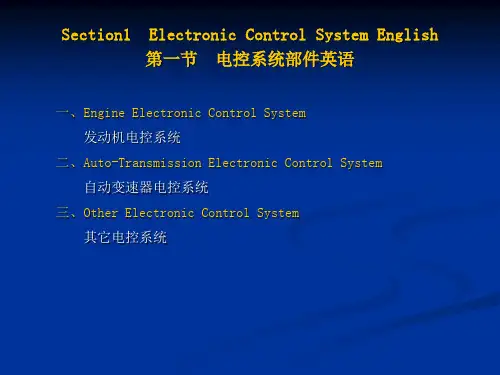
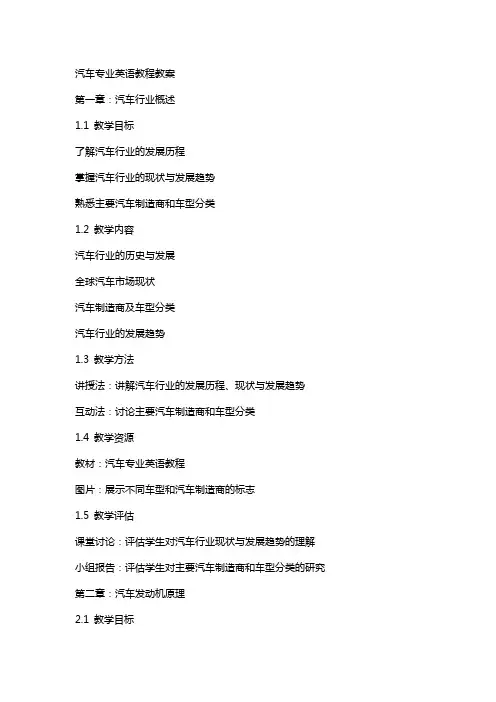
汽车专业英语教程教案第一章:汽车行业概述1.1 教学目标了解汽车行业的发展历程掌握汽车行业的现状与发展趋势熟悉主要汽车制造商和车型分类1.2 教学内容汽车行业的历史与发展全球汽车市场现状汽车制造商及车型分类汽车行业的发展趋势1.3 教学方法讲授法:讲解汽车行业的发展历程、现状与发展趋势互动法:讨论主要汽车制造商和车型分类1.4 教学资源教材:汽车专业英语教程图片:展示不同车型和汽车制造商的标志1.5 教学评估课堂讨论:评估学生对汽车行业现状与发展趋势的理解小组报告:评估学生对主要汽车制造商和车型分类的研究第二章:汽车发动机原理2.1 教学目标理解汽车发动机的基本原理掌握发动机的类型和结构熟悉发动机的工作过程和性能指标2.2 教学内容发动机的分类和结构内燃机的工作原理发动机的性能指标发动机的技术发展2.3 教学方法讲授法:讲解发动机的基本原理、类型和结构实验法:观察发动机的工作过程和性能指标2.4 教学资源教材:汽车专业英语教程实验设备:发动机实验台2.5 教学评估课堂测试:评估学生对发动机基本原理的理解实验报告:评估学生对发动机工作过程和性能指标的掌握第三章:汽车传动系统3.1 教学目标理解汽车传动系统的基本原理掌握传动系统的类型和结构熟悉传动系统的工作过程和性能指标3.2 教学内容传动系统的分类和结构手动变速器和自动变速器的工作原理传动系统的性能指标传动系统的发展趋势3.3 教学方法讲授法:讲解传动系统的基本原理、类型和结构实验法:观察传动系统的工作过程和性能指标3.4 教学资源教材:汽车专业英语教程实验设备:传动系统实验台3.5 教学评估课堂测试:评估学生对传动系统基本原理的理解实验报告:评估学生对传动系统工作过程和性能指标的掌握第四章:汽车制动系统4.1 教学目标理解汽车制动系统的基本原理掌握制动系统的类型和结构熟悉制动系统的工作过程和性能指标4.2 教学内容制动系统的分类和结构液压制动系统和电子制动系统的原理制动系统的性能指标制动系统的安全性能4.3 教学方法讲授法:讲解制动系统的基本原理、类型和结构实验法:观察制动系统的工作过程和性能指标4.4 教学资源教材:汽车专业英语教程实验设备:制动系统实验台4.5 教学评估课堂测试:评估学生对制动系统基本原理的理解实验报告:评估学生对制动系统工作过程和性能指标的掌握第五章:汽车电子控制系统5.1 教学目标理解汽车电子控制系统的基本原理掌握电子控制系统的类型和结构熟悉电子控制系统的工作过程和性能指标5.2 教学内容电子控制系统的分类和结构发动机控制单元和车辆稳定控制系统的原理电子控制系统的性能指标电子控制系统的发展趋势5.3 教学方法讲授法:讲解电子控制系统的基本原理、类型和结构实验法:观察电子控制系统的工作过程和性能指标5.4 教学资源教材:汽车专业英语教程实验设备:电子控制系统实验台5.5 教学评估课堂测试:评估学生对电子控制系统基本原理的理解实验报告:评估学生对电子控制系统工作过程和性能指标的掌握第六章:汽车车身与内饰设计6.1 教学目标理解汽车车身与内饰设计的基本原则掌握车身与内饰设计的过程和要素熟悉不同汽车品牌的车身与内饰设计特点6.2 教学内容汽车设计的基本原则和流程车身设计的要素和工艺内饰设计的要素和工艺车身与内饰设计的发展趋势6.3 教学方法讲授法:讲解汽车设计的基本原则、流程以及发展趋势案例分析法:分析不同汽车品牌的车身与内饰设计特点6.4 教学资源教材:汽车专业英语教程图片和视频资料:展示不同汽车品牌的车身与内饰设计案例6.5 教学评估课堂讨论:评估学生对汽车设计原则的理解设计项目:评估学生对车身与内饰设计过程的掌握第七章:汽车安全与环保技术7.1 教学目标理解汽车安全与环保技术的重要性掌握汽车安全与环保技术的类型和原理熟悉当前汽车安全与环保技术的发展趋势7.2 教学内容汽车安全技术:防抱死制动系统、气囊系统等环保技术:排放控制、燃油效率提升技术等安全与环保技术的发展趋势7.3 教学方法讲授法:讲解汽车安全与环保技术的类型和原理实验法:观察汽车安全与环保技术的工作过程7.4 教学资源教材:汽车专业英语教程实验设备:汽车安全与环保技术实验设备7.5 教学评估课堂测试:评估学生对汽车安全与环保技术原理的理解实验报告:评估学生对汽车安全与环保技术工作过程的掌握第八章:汽车诊断与维修技术8.1 教学目标理解汽车诊断与维修技术的基本原理掌握汽车诊断工具和维修方法熟悉汽车维修工艺和质量控制8.2 教学内容汽车诊断技术:故障诊断工具和软件维修技术:维修工艺和质量控制诊断与维修技术的发展趋势8.3 教学方法讲授法:讲解汽车诊断与维修技术的基本原理实践操作法:操作汽车诊断工具和维修设备8.4 教学资源教材:汽车专业英语教程实验设备:汽车诊断工具和维修设备8.5 教学评估课堂测试:评估学生对汽车诊断与维修技术原理的理解实践报告:评估学生对汽车诊断与维修技术操作的掌握第九章:汽车销售与服务9.1 教学目标理解汽车销售与服务的重要性掌握汽车销售与服务的流程和技巧熟悉汽车售后服务与管理9.2 教学内容汽车销售流程:销售策略、客户接待、合同签订等服务技巧:客户沟通、售后服务、投诉处理等汽车销售与服务的发展趋势9.3 教学方法讲授法:讲解汽车销售与服务的流程和技巧角色扮演法:模拟汽车销售与服务场景9.4 教学资源教材:汽车专业英语教程角色扮演道具:展示汽车销售与服务场景的道具9.5 教学评估课堂讨论:评估学生对汽车销售与服务流程的理解角色扮演报告:评估学生对汽车销售与服务技巧的掌握第十章:汽车行业发展趋势10.1 教学目标理解汽车行业的发展趋势掌握新能源汽车和智能汽车的技术特点熟悉汽车行业的未来发展方向10.2 教学内容新能源汽车:电动汽车、混合动力汽车、燃料电池汽车等智能汽车:自动驾驶、车联网、智能驾驶辅助系统等汽车行业的未来发展方向10.3 教学方法讲授法:讲解新能源汽车和智能汽车的技术特点小组讨论法:讨论汽车行业的未来发展方向10.4 教学资源教材:汽车专业英语教程视频资料:展示新能源汽车和智能汽车的技术特点10.5 教学评估课堂测试:评估学生对新能源汽车和智能汽车技术特点的理解小组报告:评估学生对汽车行业未来发展方向的探讨重点和难点解析重点环节1:发动机的工作原理和性能指标需要重点关注的内容:发动机的基本原理、类型和结构,内燃机的工作过程,以及发动机的性能指标。
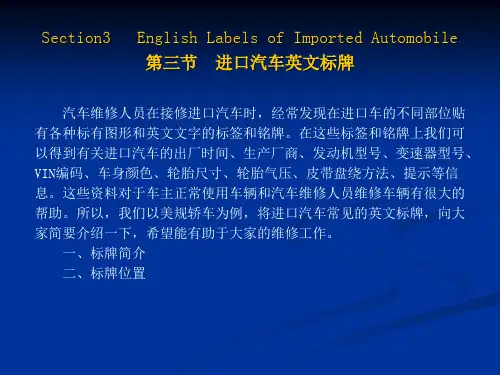
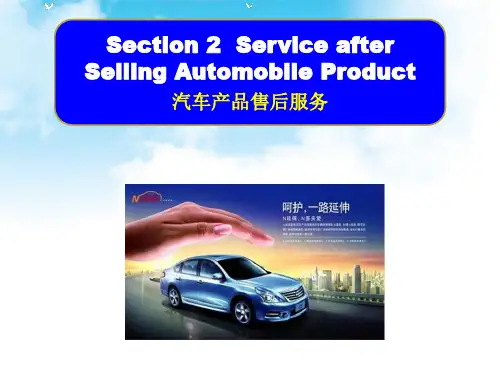
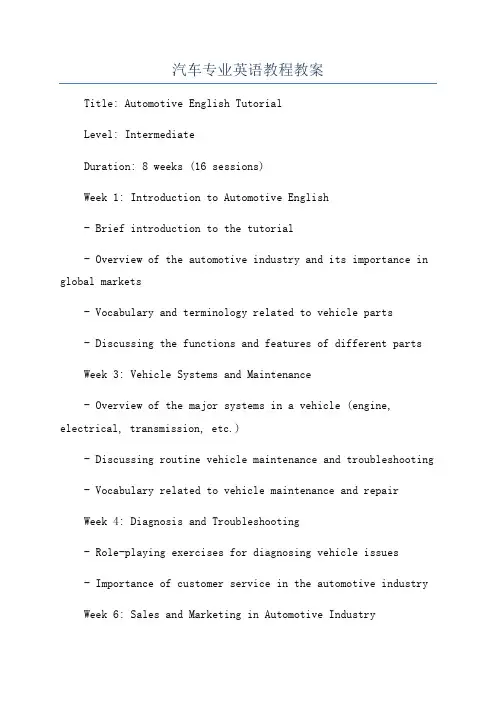
汽车专业英语教程教案Title: Automotive English TutorialLevel: IntermediateDuration: 8 weeks (16 sessions)Week 1: Introduction to Automotive English- Brief introduction to the tutorial- Overview of the automotive industry and its importance in global markets- Vocabulary and terminology related to vehicle parts- Discussing the functions and features of different parts Week 3: Vehicle Systems and Maintenance- Overview of the major systems in a vehicle (engine, electrical, transmission, etc.)- Discussing routine vehicle maintenance and troubleshooting - Vocabulary related to vehicle maintenance and repairWeek 4: Diagnosis and Troubleshooting- Role-playing exercises for diagnosing vehicle issues- Importance of customer service in the automotive industry Week 6: Sales and Marketing in Automotive Industry- Discussing sales and marketing strategies in the automotive industry- Vocabulary related to sales and marketing- Role-playing exercises for negotiating vehicle salesWeek 7: Automotive Technology and Innovation- Introduction to emerging technologies in the automotive industry- Vocabulary related to automotive technology and innovation - Discussing the impact of technology on the industryWeek 8: Presentations and Final Review- Students will prepare and deliver short presentations on a chosen automotive topic- Final review of vocabulary, grammar, and industry-specific language- Evaluation and feedback sessionTeaching Methodology:- Lectures and discussions on automotive industry topics- Role-playing exercises to simulate real-life scenarios- Vocabulary-building activities (flashcards, word games, etc.)- Regular evaluations to track progress and provide feedback Assessment:- Weekly quizzes to measure understanding of vocabulary and industry knowledge- Participation in discussions and role-plays- Final presentation on an automotive topic- Final evaluation based on overall progressNote: The duration and specific topics of the tutorial can be adjusted based on the needs and level of the students. Additional resources such as textbooks, articles, and audiovisual materials can be incorporated to enhance the learning experience.。
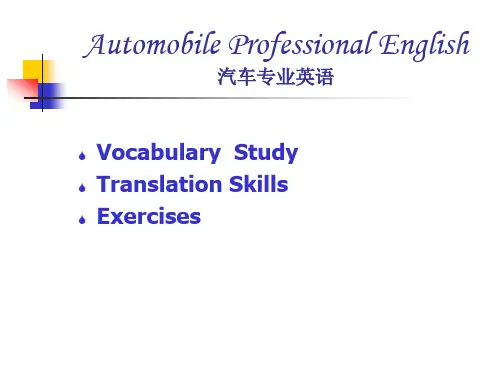
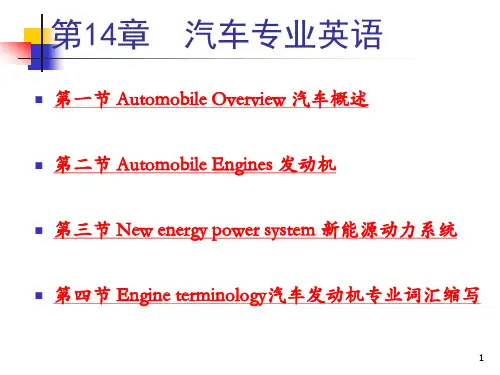
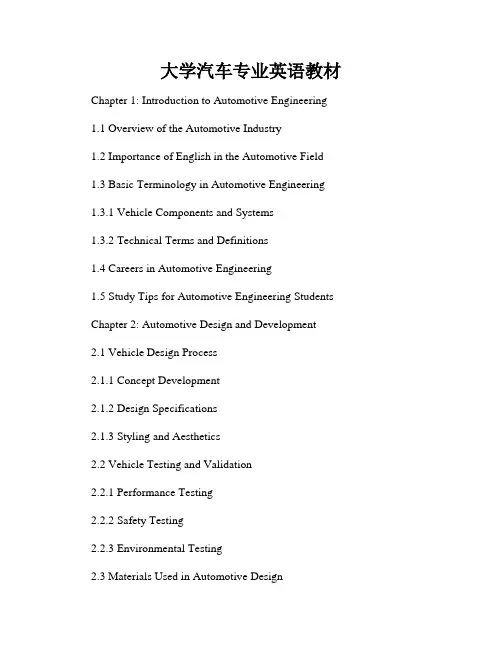
大学汽车专业英语教材Chapter 1: Introduction to Automotive Engineering 1.1 Overview of the Automotive Industry1.2 Importance of English in the Automotive Field 1.3 Basic Terminology in Automotive Engineering 1.3.1 Vehicle Components and Systems1.3.2 Technical Terms and Definitions1.4 Careers in Automotive Engineering1.5 Study Tips for Automotive Engineering Students Chapter 2: Automotive Design and Development2.1 Vehicle Design Process2.1.1 Concept Development2.1.2 Design Specifications2.1.3 Styling and Aesthetics2.2 Vehicle Testing and Validation2.2.1 Performance Testing2.2.2 Safety Testing2.2.3 Environmental Testing2.3 Materials Used in Automotive Design2.3.1 Metals2.3.2 Polymers2.3.3 Composites2.4 Case Studies of Successful Automotive Design Projects Chapter 3: Automotive Powertrain Systems3.1 Internal Combustion Engines3.1.1 Engine Components and Operations3.1.2 Types of Engines3.1.3 Alternative Powertrain Technologies3.2 Transmission Systems3.2.1 Manual Transmissions3.2.2 Automatic Transmissions3.2.3 Continuously Variable Transmissions (CVTs)3.3 Hybrid and Electric Vehicle Technologies3.3.1 Hybrid Electric Vehicles3.3.2 Plug-in Hybrid Electric Vehicles3.3.3 Electric Vehicles3.4 Case Studies on Innovative Powertrain Systems Chapter 4: Automotive Electronics and Control Systems4.1 Introduction to Automotive Electronics4.2 Engine Control Systems4.2.1 Electronic Fuel Injection (EFI)4.2.2 Ignition Systems4.2.3 Engine Management Systems4.3 Vehicle Communication Systems4.3.1 Controller Area Network (CAN)4.3.2 In-Car Entertainment Systems4.3.3 Telematics Systems4.4 Advanced Driver Assistance Systems (ADAS)4.4.1 Adaptive Cruise Control4.4.2 Lane Departure Warning Systems4.4.3 Collision Avoidance Systems4.5 Case Studies on Automotive Electronics and Control Systems Chapter 5: Vehicle Dynamics and Suspension Systems5.1 Basics of Vehicle Dynamics5.1.1 Vehicle Handling and Stability5.1.2 Tire Behavior and Performance5.1.3 Braking Systems5.2 Suspension Systems5.2.1 Types of suspensions5.2.2 Suspension Design and Tuning5.3 Steering Systems5.3.1 Rack and Pinion Steering5.3.2 Power Steering Systems5.3.3 Electronic Steering Systems5.4 Case Studies on Vehicle Dynamics and Suspension Systems Chapter 6: Automotive Safety and Crashworthiness6.1 Importance of Automotive Safety6.2 Passive Safety Systems6.2.1 Seatbelts and Restraint Systems6.2.2 Airbag Systems6.2.3 Safety Cage Design6.3 Active Safety Systems6.3.1 Anti-lock Braking Systems (ABS)6.3.2 Electronic Stability Control (ESC)6.3.3 Adaptive Headlights6.4 Crashworthiness and Impact Analysis6.4.1 Crash Simulation and Testing6.4.2 Energy Absorption Structures6.4.3 Case Studies on Automotive SafetyChapter 7: Automotive Manufacturing and Quality Control7.1 Automotive Manufacturing Processes7.1.1 Stamping7.1.2 Welding7.1.3 Assembly7.2 Lean Manufacturing Principles in the Automotive Industry7.3 Quality Control and Assurance7.3.1 Six Sigma Methodology7.3.2 Statistical Process Control7.3.3 Failure Mode and Effects Analysis (FMEA)7.4 Case Studies on Automotive Manufacturing and Quality ControlConclusionIn conclusion, this English textbook for university-level automotive engineering students provides comprehensive coverage of essential topics in the field. From the fundamentals of automotive design and development to advanced concepts in automotive electronics and control systems, this textbook aims to equip students with the necessary knowledge and skills tosucceed in their future careers. By studying this textbook, students will gain a solid foundation in both technical English vocabulary and automotive engineering principles.。
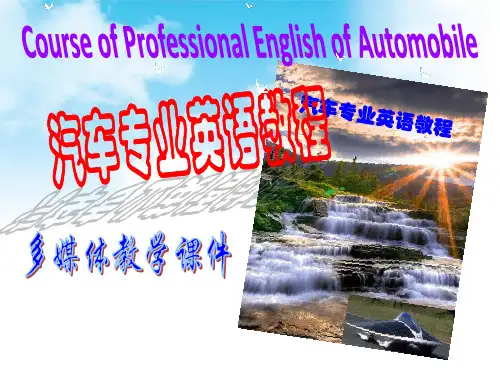
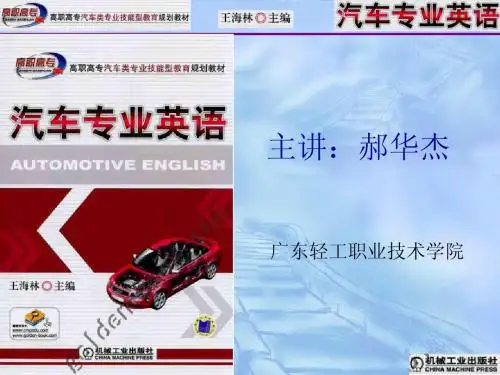
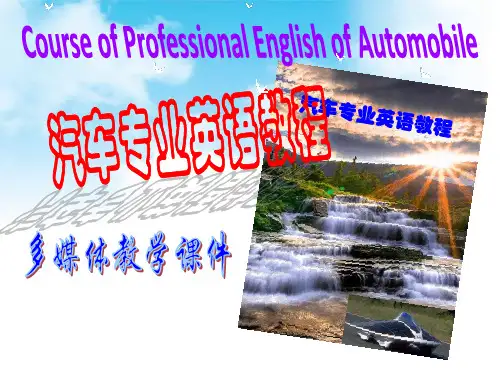
unit 1 点火、灯自动关闭系统这部分主要告诉我们怎样理解电路修复因为在理解电路修复后,我们可以开始排除故障的原因。
当故障排除任何问题,首先开始理解故障在哪里发生的,电源提供电力给电路和节点。
每一个系统电路实际布线都是从电源的角度来显示的,每个接地点都有电池的接收方式。
(所有的电路图都显示在关闭位置的开关。
)1。
智能点火功能:1)当电源软件是用制动踏板推。
在车辆确认标识码。
当IL证实,发动机防盗器使发动机启动。
2)当电源软件被推入无制动踏板的时候,在车辆上确认标识码。
当它被确认。
发动机防盗系统允许供电方式改变“ACC”到“点火”到“关”的圈子,按下电源开关。
3)如果电源开关推车的平稳条件下运行的发动机,发动机停止和发动机防盗设置。
2。
光自动关闭系统,该系统会自动关闭尾灯或头灯根据门打开或关闭驾驶员侧,并防止未关掉灯。
如果点火从打开到关闭(点火开关型)或电源开关在从点火到关闭(电源开关型)与尾灯或头灯同时打开。
如果在那个时候,司机的侧门是开的。
从车门SW信号(驾驶员侧)终端的前排乘客侧的J/B ecu。
信号关闭尾灯由多路通信实现.unit 2该系统利用发动机ECU和保持发动机综合控制、传输等方面的自动控制,说明如下1.输入信号1)水温度信号, 根据发动机冷却液温度,水温传感器检测发动机冷却液温度与电阻变化。
发动机冷却液温度。
是到发动机ECU端子的输入信号2),进气温度信号进气温度传感器安装在空气流量计和进气管,这是输入的控制信号到发动机ECU端子THA。
3)氧传感器信号电路中的尾气氧浓度检测和输入,是由排气决定的,控制氧传感器的发动机ECU端子oxib和ox2b控制信号。
传感器被加热,这种热水器也由发动机ECU控制。
4)转速信号电路。
凸轮轴的位置是由曲轴位置传感器的检测,2号RH排气侧。
RH进气侧和排气侧),LH 曲轴位置传感器3 LH 侧)及其信号输入端子EVI。
ev2.发动机ECU控制信号。